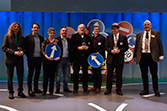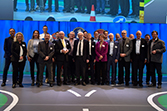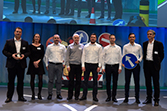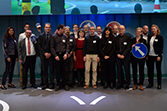The winners of the 2020 Watt d'Or awards have been chosen! This year's trophies were presented to the winners on the occasion of the Swiss Federal Office of Energy's New Year's event that was held on 9 January 2020 in Bern. The following projects were chosen to receive the various awards (all of which are of equal value):
“Energy technologies” category

ZHAW-IEFE, Schmid Hutter AG Winterthur, Meyer Orchideen AG: A Thermochemical energy network in a greenhouse
Since almost 10 years, the greenhouse of Meyer Orchideen AG in Wangen near Dübendorf has been producing orchids in a climate-neutral way. There could not be a more suitable location to test the innovative novel technology of thermochemical networks, which are studied in the framework of the European research project H-DisNet. These networks can store energy in the form of chemical potential in a saline solution for any length of time without any energy loss. In the orchid greenhouse, the Institute for Energy Systems and Fluid Engineering (IEFE) of the University of Applied Sciences Zurich (ZHAW) has set up an application of a thermochemical network in collaboration with the air conditioning and ventilation specialist Schmid Hutter AG Winterthur. Here the new technology is being used to reduce energy consumption for air conditioning by up to 50%. In the future, however, the focus will be on the application of the technology in smart local and regional energy networks as a storage solution.
“Renewable energy” category

Regio Energie Solothurn: Biological methanation with archaea in a hybrid plant
What is the link between flatulence and renewable energy? The answer is Archie, the farting archaeobacteria in the service of Regio Energie Solothurn in Zuchwil, Solothurn, and of the European research project STORE&GO. Archie ingests hydrogen and CO2 and converts them into biomethane, which is then fed into the natural gas grid. This biological methanation takes place in the Regio Energie Solothurn hybrid plant. In operation since 2015, this plant is equipped with an electrolyser, which produces solar hydrogen, a hydrogen storage tank and a cogeneration unit. Archie fits in logically with this innovative overall concept, and helps the public better understand the complex technical processes.
“Energy-efficient mobility” category

Viktor Meili AG: Municipal e-vehicles by Victor Meili AG
They are part of the scene in every town and village: municipal vehicles. The small vehicles sweep the streets, clear away branches, leaves and rubbish or keep paths free from snow and ice. As they do so, they usually cause a lot of noise and emit stinking clouds of diesel fumes. That now no longer needs to be the case because the electric municipal vehicles developed by the Swiss family firm Viktor Meili AG in Schübelbach over the last 10 years are on the starting grid. They are at least as powerful as their diesel equivalents, and have a long period of use per battery charge. They are also very quiet, emit no CO2 and save around CHF 100 000 in fuel and maintenance costs over their lifetime.

Designwerk Products AG: The 26-ton Futuricum Collect 26E electric truck by Designwerk
Garbage trucks must be strong and durable. They stop-and-go through the streets to pick up everything we want to get rid of. But they are very noisy and have an unpleasant diesel perfume. The Designwerk company from Winterthur has recognized that garbage trucks are an ideal application for electric propulsion. In a three-year lighthouse project, they developed the 26-ton Futuricum Collect 26E electric truck. It is currently proving its worth on a daily basis in Thun, Murten, Lausanne and Neuchâtel, quietly and CO2-free in its daily employment. It is certainly still about twice as expensive to buy as diesel models, but its operating costs are about 80% lower. Designwerk Products AG is now starting series production at its Winterthur site, and intends to develop further applications for heavy electric commercial vehicles in the future.
“Buildings and space” category

ETH Zurich: The anergy grid at the ETH Zurich Campus Hönggerberg
More than 12’000 students and staff populate the Hönggerberg campus of ETH Zurich every day, consuming as much energy as a small town. A good enough reason for ETH Zurich to pursue a consistent energy strategy: By 2040 it wants to reduce its CO2 emissions by 80% despite the planned expansion of the campus. Part of this strategy is the renewable heating supply of the Hönggerberg campus. Since 2012, several 200-metre-deep geothermal probe fields store waste heat underground in summer and release it again for heating in winter. An anergy grid, a low-temperature distribution system, transports the energy. Depending on the heating requirements of the buildings, five energy distribution centres extract or pump water from or into the anergy loop. A continuous operational monitoring ensures the ongoing optimization of the system, and also provides data for the future expansion of the campus.
Documents
Watt d'Or 2020
- Portraits of winners of Watt d'Or 2020
(PDF, 3.6 MB, 09.01.2020) ID: 9993 | 609
Links
Media
Last modification 09.01.2020





